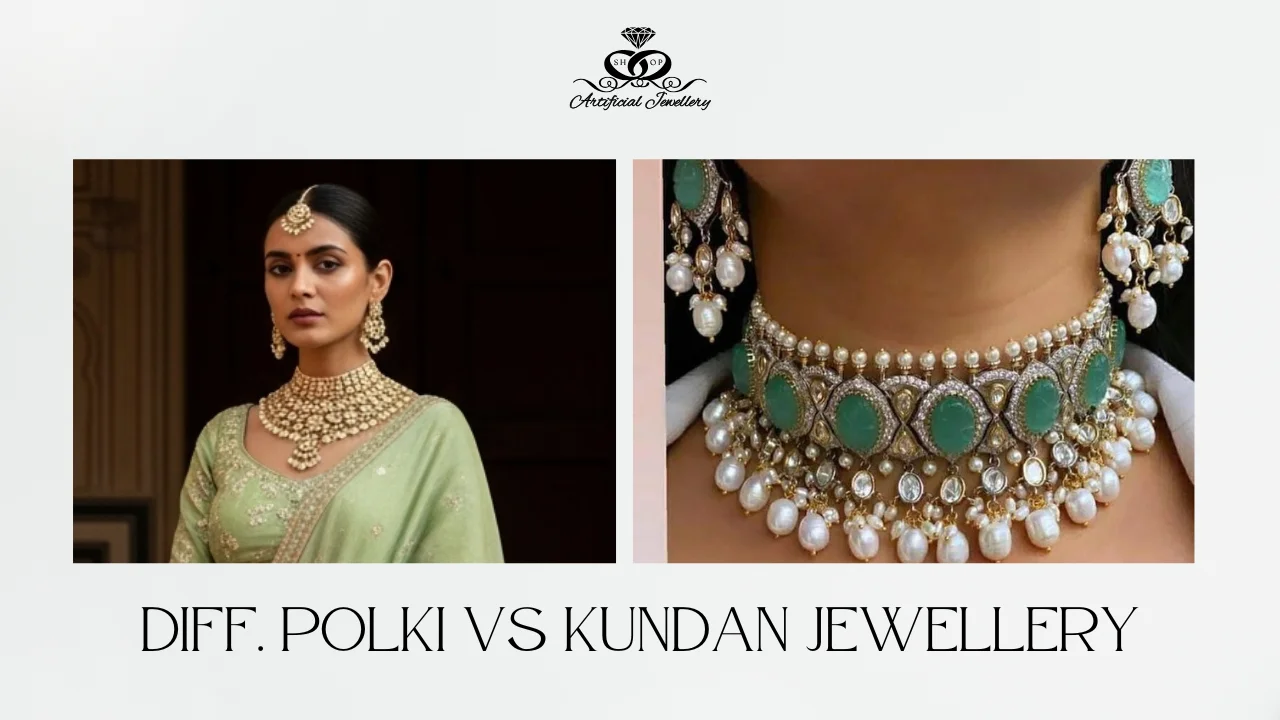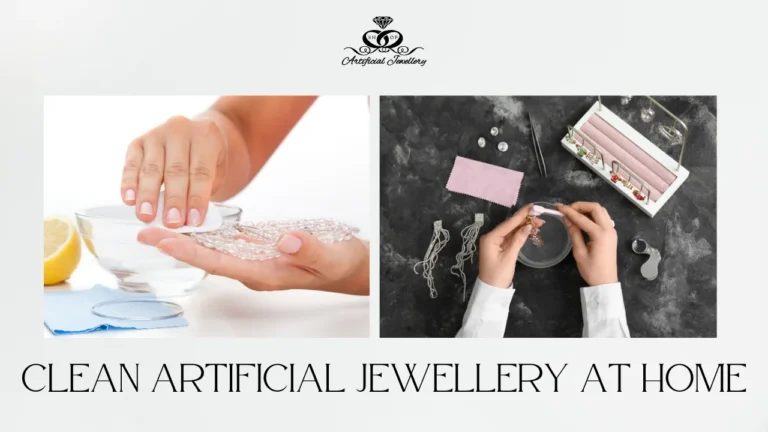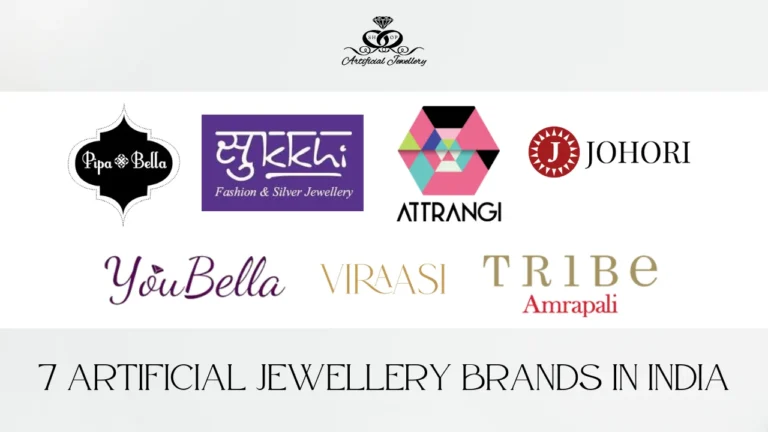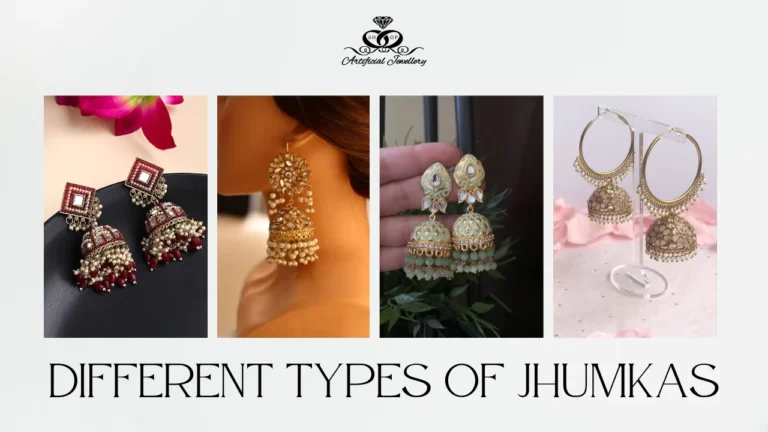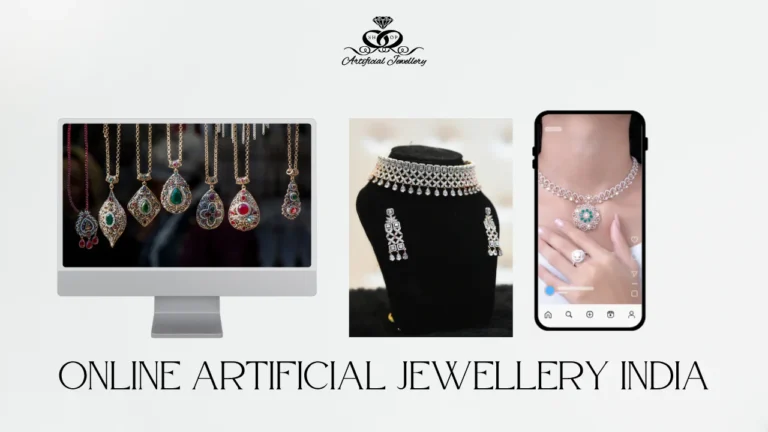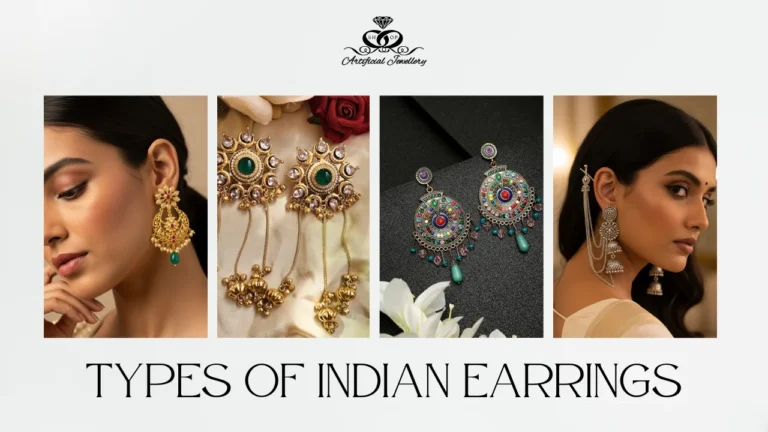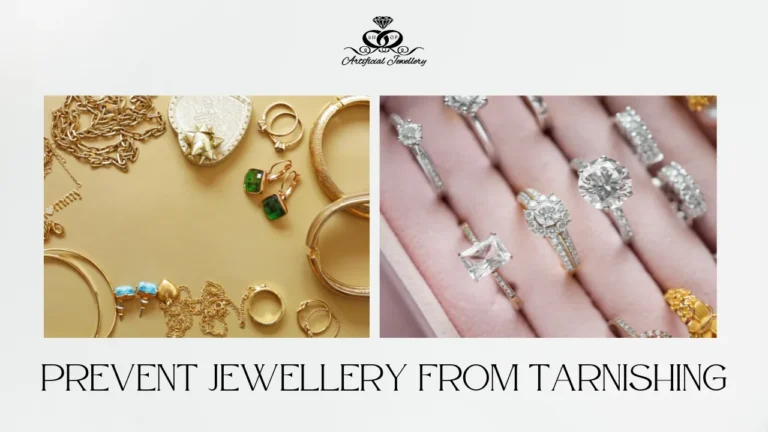Stepping into the mesmerizing world of Indian jewellery, you’re bound to encounter two names that radiate unparalleled grandeur: Kundan and Polki. Both tell tales of royal heritage and exquisite craftsmanship, gracing brides and grand celebrations for centuries. But for many, the intricate differences between these two traditional treasures remain a shimmering mystery.
Are they the same? Is one better than the other? How do you choose? If these questions have ever crossed your mind, you’re in the right place. We’re here to unravel the enchanting distinctions, demystify the myths, and help you pick the perfect sparkle that resonates with your style and occasion.
The Heart of the Craft: Understanding Jadau
Before we dive into their individual brilliance, let’s talk about what often ties Polki and Kundan together: the Jadau technique.
Originating from Rajasthan and perfected during the Mughal era, Jadau is an ancient art of setting gemstones into a metal (typically gold) without using any external adhesive.
The stones are embedded into a softened lac (natural resin) base, and then gold foil is meticulously pressed around them, creating a secure and seamless setting. This labor-intensive method gives both Kundan and Polki their distinct, opulent look.
Polki Jewellery: The Raw Brilliance of Uncut Diamonds
Imagine diamonds in their most untouched, natural state – that’s Polki. Hailing from the royal courts of the Mughals, Polki jewellery is celebrated for its rustic, antique charm and a unique, soft glow that polished diamonds can’t replicate.
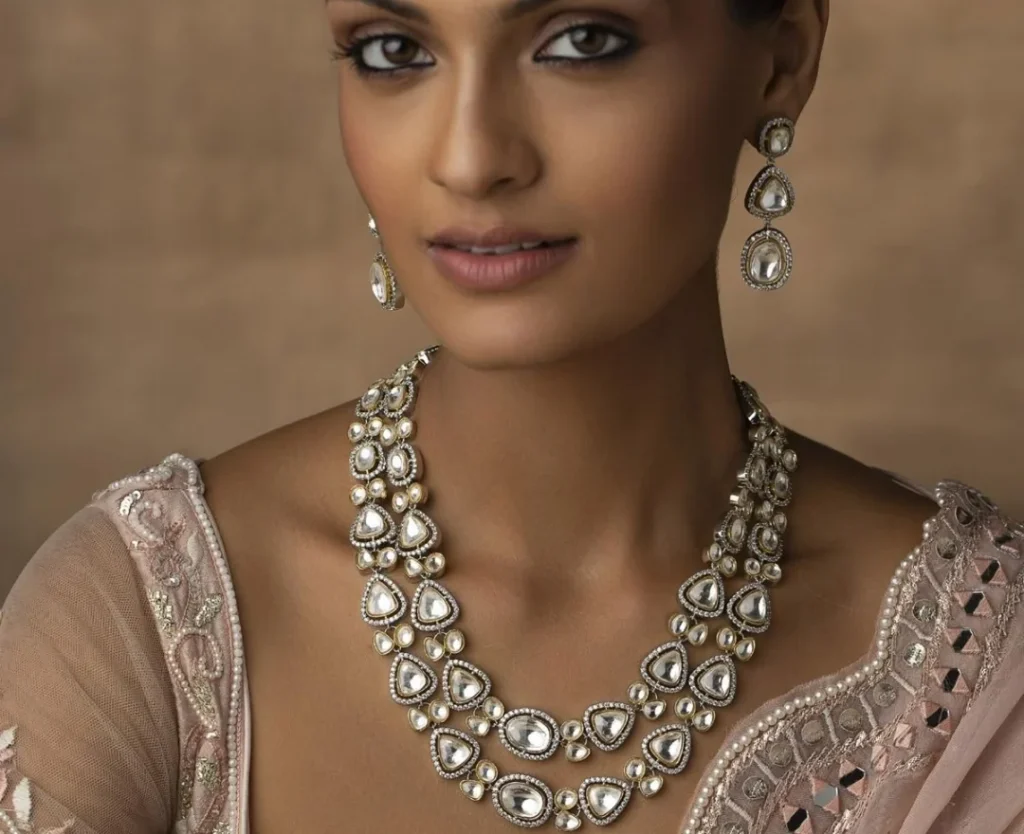
- The Material: Polki is crafted using uncut, unpolished natural diamonds. These diamonds retain their raw, organic form, with minimal processing. They don’t have the crisp facets of modern cut diamonds, giving them a subtle, earthy shimmer.
- The Setting: These uncut diamonds are individually hand-set into pure gold (typically 22K or 24K) using the Jadau technique. Thin gold foils are carefully wrapped around the diamonds to secure them and enhance their natural luster.
- The Look & Feel: Polki pieces exude a regal, understated elegance. They have a warm, authentic sparkle that speaks of heritage and timelessness. Due to the solid gold and diamonds, Polki jewellery is generally heavier and feels substantial.
- Value & Investment: As it features real, natural diamonds, Polki jewellery is significantly more expensive than Kundan. It’s often considered an investment piece and can hold significant resale value, making it an heirloom to pass down through generations.
- Occasion: Best suited for grand occasions, especially bridal wear, significant festivals, and royal-themed events where luxury and tradition are paramount.
Kundan Jewellery: The Art of Layered Luster
Kundan, meaning ‘highly refined gold’, is an older art form, deeply rooted in the royal traditions of Rajasthan and Gujarat. It’s known for its intricate designs and vibrant, multi-layered appearance.
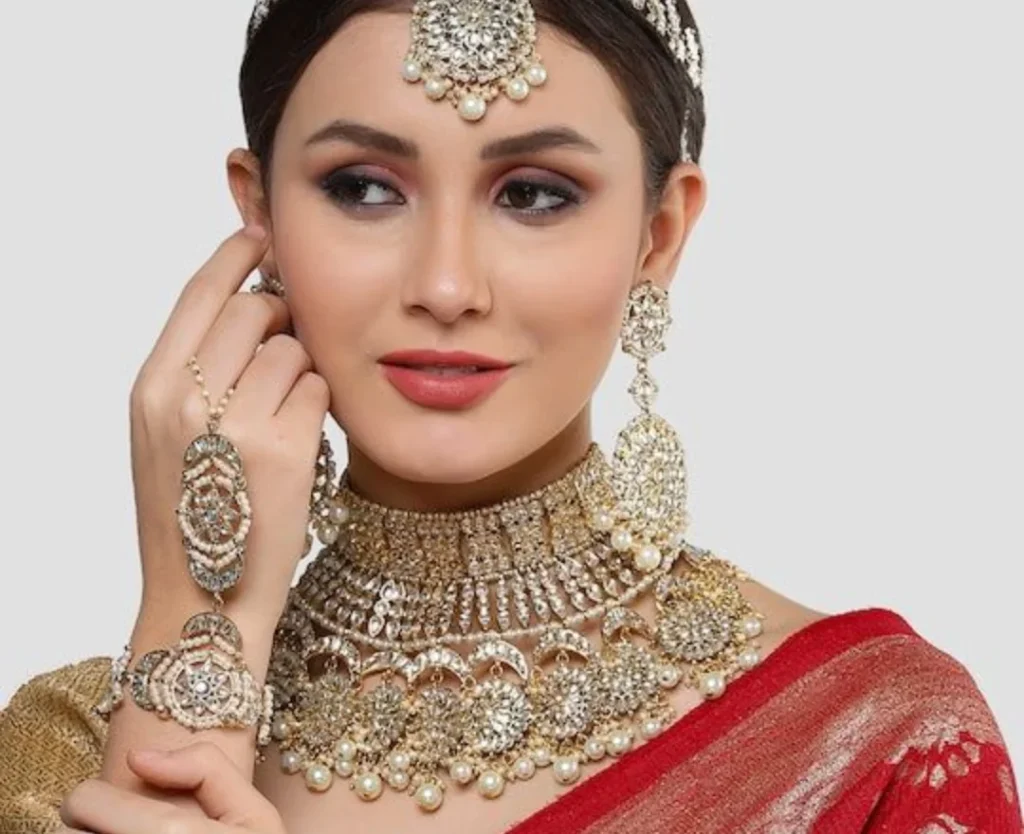
- The Material: Unlike Polki, Kundan jewellery primarily uses refined glass stones or sometimes semi-precious gemstones. The term “Kundan” refers specifically to the pure 24K gold used to create the setting.
- The Setting: These glass stones are meticulously set into a lac base, with layers of pure gold foil painstakingly pressed around them to create the desired design and hold the stones securely. This gold foil reflects light, giving the glass stones a captivating, glossy shine.
- The Look & Feel: Kundan jewellery is typically more elaborate and ornate, often featuring intricate patterns, vibrant color combinations, and Meenakari (colorful enamel work) on the reverse side, making it beautiful from all angles. It has a bright, almost crystal-like sparkle. Kundan pieces are generally lighter than Polki due to the use of glass and lac.
- Value & Affordability: As it uses glass stones instead of diamonds, Kundan jewellery is more affordable than Polki. This allows for larger, more elaborate designs within a more accessible budget.
- Occasion: Highly versatile, Kundan is popular for pre-wedding functions like Mehndi and Sangeet, festive wear, and traditional bridal sets, offering a majestic look without the premium price tag.
Key Points Difference Between Polki and Kundan Jewellery
| Feature | Polki Jewellery | Kundan Jewellery |
|---|---|---|
| Core Material | Uncut, unpolished Natural Diamonds | Refined Glass Stones or semi-precious gems |
| Shine & Sparkle | Soft, natural, antique glow (often slightly opaque) | Bright, glossy, clear (like glass), often with vibrant colors reflecting off gold foil |
| Value & Price | Significantly More Expensive (due to real diamonds), considered an investment | More Affordable (due to glass stones), allowing for larger designs within budget |
| Weight | Generally Heavier | Generally Lighter |
| Gold Usage | Typically 22K/24K solid gold for setting | 24K pure gold foil (Kundan) used to set stones over a lac base. Often features Meenakari work. (Can also be made in “open setting” without lac for a lighter, more contemporary feel) |
| Resale Value | Higher (due to real diamond and gold content) | Lower (intrinsic value tied to gold content, not glass stones) |
| Craftsmanship | Focus on showcasing the raw diamond’s beauty, meticulous hand-setting | Intricate layering of gold foil to create patterns and hold glass stones; often ornate and highly detailed. |
| Origin | Mughal Era | Ancient Rajasthani/Gujarati tradition |
Demystifying Common Misconceptions
- “Is Polki just an uncut diamond?”
- While largely true, “Polki” in the modern context often refers to a thin slice of diamond that is minimally polished. There are different grades (Syndicate, Zimbabwe, Khilwas), and even Polki can undergo treatments (like filler insertion) to enhance clarity. Always ask for details on quality and any treatments.
- “Kundan is just fake jewelry.”
- This is a major misconception! “Kundan” refers to the technique of using highly refined pure gold (24K) to set stones. While modern Kundan often uses glass, the craftsmanship itself is an intricate, ancient art form that is anything but “fake.” Authentic Kundan pieces with genuine craftsmanship are highly valued.
- “How can I tell if it’s real Polki or Kundan?”
- Polki: Look for the natural irregularities and imperfect shapes of uncut diamonds. Real Polki diamonds won’t sparkle with the sharp, fiery brilliance of a cut diamond; they’ll have a softer, more rustic glow. The back will often show the pure gold setting.
- Kundan: Observe the intricate gold foil work around the stones. If you can see the back, traditional Jadau Kundan will show gold, while “open setting” Kundan will allow you to see through the glass stones from the rear. Genuine Kundan involves meticulous hand-craftsmanship, not just glued-on pieces.
- “Which one should I choose for my wedding?”
- For a high-value heirloom, ultimate luxury, and antique regal charm: Go for Polki. It’s an investment that can be passed down.
- For vibrant colors, elaborate designs, and a more budget-friendly yet traditional look: Kundan is an excellent choice. It offers immense versatility for various wedding functions and can be quite striking.
- The best of both worlds: Many contemporary bridal sets now beautifully mix Polki and Kundan, combining the raw elegance of uncut diamonds with the vibrant artistry of glass stones and Meenakari work. This fusion trend allows for unique, personalized pieces.
- “How do I maintain my Polki and Kundan jewellery?”
- Both require care, but their needs differ:
- Kundan: More delicate due to the lac base and glass stones. Keep away from water, perfumes, and harsh chemicals. Store in an airtight, dry container. Clean gently with a soft, dry cloth.
- Polki: Sturdier due to real diamonds and solid gold. Still avoid harsh chemicals. Occasional professional cleaning is recommended to maintain its shine. Store carefully to prevent scratches.
- Both require care, but their needs differ:
Your Final Sparkle: Making the Right Choice
Ultimately, the choice between Polki and Kundan comes down to your personal preference, budget, and the occasion. Both are timeless expressions of Indian artistry, each offering a unique charm.
Whether you’re drawn to the raw, natural brilliance of Polki’s uncut diamonds or the vibrant, intricate layers of Kundan’s gold foil artistry, you’re investing in a piece of heritage. Try them on, feel their essence, and choose the one that truly makes your heart sparkle. After all, the most beautiful jewellery is the one that tells your story.
FAQs
What is the primary difference between Kundan and Polki jewellery?
The main difference lies in the material used. Polki jewellery features uncut, natural diamonds, while Kundan jewellery uses glass stones (or sometimes semi-precious gems) set into a pure gold foil base.
Is Polki more expensive than Kundan?
Yes, Polki is significantly more expensive than Kundan. This is because Polki uses real, natural diamonds, which are inherently valuable, whereas Kundan uses glass stones.
Which one is better: Kundan or Polki?
Neither is inherently “better” – it depends on your preference, budget, and the occasion. Polki offers higher intrinsic value and a regal, antique look, while Kundan provides vibrant designs and intricate craftsmanship at a more accessible price point.
How can I tell if Polki is real?
Real Polki diamonds will have natural irregularities and a softer, more rustic glow (not the fiery sparkle of cut diamonds). Authentic pieces will also be set in pure gold, and you won’t typically see through them like glass.
Can Kundan jewellery be customized with different colors?
Absolutely! Kundan jewellery is renowned for its versatility in color. The glass stones can come in a vast array of hues, and the intricate Meenakari (enamel work) on the reverse allows for stunning customization with vibrant colors.

